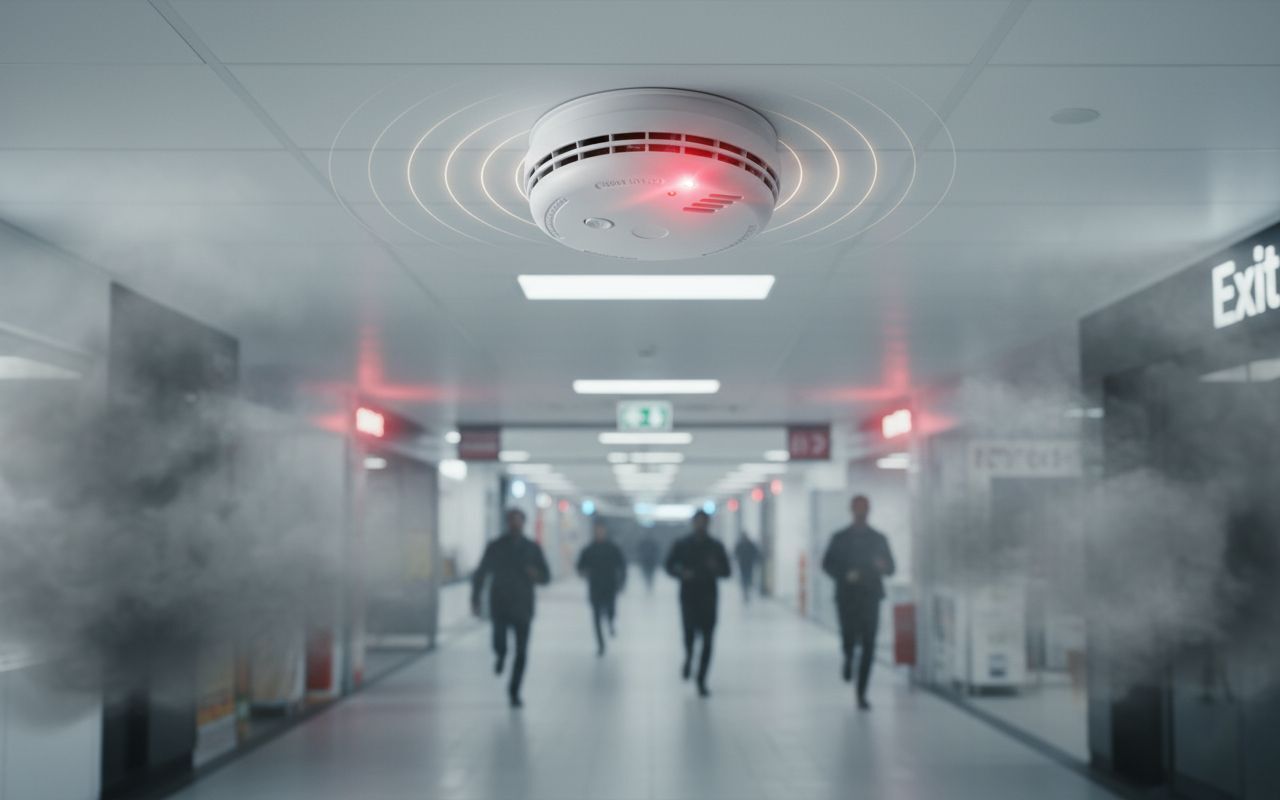
When it comes to keeping Australian homes and buildings safe, Smoke and Heat Alarms are no longer a “nice-to-have” they’re essential. From Brisbane apartments to Melbourne renovations, the right alarm can mean the difference between a minor scare and a major disaster. But between photoelectric sensors, 240V hardwired setups, and modern interconnected alarms, choosing the right type can get confusing especially with state regulations changing every few years.
This guide breaks it down simply what each type does, what Australian standards say, when you need to upgrade, and how to pick the best option without overpaying.
Why Smoke and Heat Alarms Matter
A smoke alarm isn’t just a box on the ceiling it’s the first line of defence against fires starting unnoticed. Photoelectric alarms detect smouldering fires (like electrical faults or overheated wiring) early, while heat alarms are designed for kitchens, garages, or dusty areas where regular smoke alarms might trigger false alarms.
For builders, landlords, and strata managers, compliance with the latest Australian standards means more than ticking a box it’s about protecting property and meeting legal obligations under state-based fire safety laws.
Understanding the Three Main Types of Smoke Alarms
Before diving into state regulations, let’s look at the key differences between alarm types.
1. Photoelectric Smoke Alarms
These are now the gold standard across most Australian states. Photoelectric sensors detect visible smoke particles ideal for slow, smouldering fires. They’re less prone to false alarms from cooking steam or dust and offer better early warning in most real-world fire scenarios.
Ideal for: Bedrooms, hallways, living rooms, and any area where fires are likely to start slowly.
2. Ionisation Alarms
Once popular, these have been largely phased out due to sensitivity issues and environmental concerns (they contain a small radioactive source). They respond faster to flaming fires but are not recommended for general use anymore.
Ideal for: No longer recommended under most state regulations.
3. 240V Hardwired Alarms
These are directly connected to the home’s mains power (240 volts) and usually come with a backup battery. Many newer models are also interconnected, meaning if one goes off, they all sound a must-have in multi-room properties or apartments.
Ideal for: Builders or electricians wiring new homes or major renovations.
State-by-State Smoke Alarm Requirements (2025 Update)
Smoke alarm laws in Australia differ slightly between states and territories, but most have moved toward photoelectric, interconnected alarms.
Queensland
- All properties must have photoelectric, interconnected alarms (wired or wireless).
- Must be installed in every bedroom, hallway, and on each level.
- Battery-powered alarms must be sealed 10-year lithium types.
- Full compliance required for rentals and new builds.
New South Wales
- Requires at least one working smoke alarm on every level.
- Photoelectric alarms are recommended, not mandatory — but strongly advised.
- Interconnection is required for new builds or major renovations.
Victoria
- Smoke alarms must be installed in accordance with AS 3786.
- Photoelectric models are strongly recommended.
- For new homes, hardwired (240V) alarms with backup batteries are required.
South Australia
- All homes must have smoke alarms — wired (240V) for new homes, or battery-powered if installed before 1995.
- Photoelectric sensors preferred for all replacements.
Western Australia
- Requires hardwired smoke alarms for new homes or when property ownership changes.
- Must comply with AS 3786.
- Battery alarms only allowed in existing homes built before 1997.
Tasmania, ACT & NT
- Similar to NSW photoelectric alarms are the recommended standard.
- Interconnection encouraged for multi-level or multi-room buildings.
Interconnected Alarms: The New Standard
Interconnected alarms have changed the game. Whether they’re wired together (240V) or wirelessly connected, they allow all alarms in the building to sound simultaneously.
This is particularly important for:
- Strata and multi-level homes, where a fire in one room may go unnoticed elsewhere.
- Rental properties, where compliance is closely audited.
- Commercial or mixed-use spaces, where early warnings can save lives and prevent asset loss.
In short, if you’re upgrading or building, go interconnected it’s safer, future-proof, and aligns with upcoming code updates.
Heat Alarms: The Unsung Heroes
While smoke alarms grab all the attention, heat alarms are equally important especially in rooms prone to steam, smoke, or dust. Heat alarms detect rapid rises in temperature rather than smoke particles.
Where to use them:
- Kitchens (to avoid false triggers)
- Garages
- Workshops
- Laundry areas
Pairing heat alarms with photoelectric smoke alarms creates a balanced, whole-property protection setup.
AS/NZS Standards You Must Know
All alarms installed in Australia must comply with AS 3786:2014 (for smoke alarms) or AS 1670.1 (for system-connected units).
For interconnected alarms, wireless options must also comply with AS/NZS 4268 (radio communication standards). If you’re a builder or strata manager, make sure you’re sourcing alarms that carry compliance markings and documentation non-compliant imports can cause issues during inspections or insurance claims.
Replacement Cycles: Don’t Ignore This
Even the best alarm doesn’t last forever. Most models have a 10-year lifespan, and replacement is mandatory once that period is up. Builders should include this in handover documentation, while landlords must track install dates for compliance checks.
Tip: When in doubt, check the manufacturing date printed on the alarm body — if it’s nearing 10 years, replace it.
Common Audit Fails to Avoid
During compliance checks or audits, these are the most common issues found:
- Non-photoelectric units still in use (especially old ionisation types)
- Flat or missing backup batteries in hardwired units
- No interconnection where required by law
- Incorrect placement alarms too close to air vents or corners
- Outdated units beyond their 10-year lifespan
Avoiding these not only keeps occupants safe but also prevents costly re-inspection fees or failed compliance certificates.
Buying Smart: Photoelectric vs 240V vs Battery What’s Worth It?
Type | Power Source | Best Use | Approx. Cost | Notes |
Photoelectric (Battery) | 10-year lithium | Retrofits, rentals | $25–$40 | Easy DIY install |
240V Hardwired | Mains + backup battery | New builds | $35–$60 | Must be installed by an electrician |
Interconnected (Wireless) | Battery or 240V | Multi-room homes | $60–$120 | Easiest compliance option |
Heat Alarm | 240V or lithium battery | Kitchens, garages | $30–$50 | Complements smoke alarms |
Bulk-Buy Tips for Builders & Property Managers
If you’re managing multiple dwellings or working on larger builds, it makes sense to buy alarms in bulk. Many suppliers, including AGM Electrical Supplies, offer trade pricing on bulk purchases of photoelectric and 240V interconnected alarms, especially when bought alongside switches, RCBOs, or cabling gear.
When you’re buying bulk:
- Confirm all units meet AS/NZS standards.
- Stick to trusted brands (Clipsal, SAL, or Emerald Planet).
- Order extra backup units replacements are easier when stock matches your existing installations.
Build Safety In Don’t Bolt It On
In 2025, every new build, renovation, and managed property in Australia needs to meet modern smoke alarm standards and doing it right doesn’t have to cost a fortune. Choosing photoelectric, interconnected alarms and pairing them with heat detectors in the right zones ensures you’re not just compliant, but genuinely safer.
Where to Buy Reliable Smoke & Heat Alarms in Australia
For builders, strata managers, or landlords looking to stay compliant without overpaying, AGM Electrical Supplies offers a range of photoelectric, 240V, and interconnected smoke and heat alarms that meet AS/NZS 3786 standards. With bulk discounts, trade pricing, and fast nationwide delivery, Electrical Wholesaler AGM makes it easy to source what you need for any job site or upgrade project.
Visit AGM Electrical Supplies today to find the right alarm setup for your property and keep every job site safe, compliant, and future-ready.
FAQs
Are 240V smoke alarms better than battery-powered ones?
240V smoke alarms are hardwired into the home’s electrical system and include a backup battery, making them more reliable for long-term use. Battery-powered alarms, especially 10-year lithium types, are great for retrofits or rentals.
Do smoke alarms in Australia need to be interconnected?
Yes in most states, new homes and rental properties must use interconnected smoke alarms so that when one goes off, all sound together. It’s now mandatory in Queensland and recommended elsewhere.
How often should smoke alarms be replaced?
All smoke and heat alarms should be replaced every 10 years, as per Australian Standard AS 3786:2014. Always check the manufacture date on the unit to ensure compliance.
Where can I buy AS/NZS-compliant smoke and heat alarms in Australia?
You can find a wide range of photoelectric, 240V, and interconnected smoke and heat alarms at AGM Electrical Supplies all fully compliant with Australian safety standards and available with trade pricing.
Comments
No posts found
Recent posts
SMS, Wechat and Whatsapp Contact Details:
For quotes, orders or to get the latest product and pricing news
PLEASE NOTE: We Do Not ANSWER Phone Calls (messages only) and We only respond during business hours.-
Mobile for SMS only

-
Text Message on Whatsapp
 scan Me
scan Me -
Text Message on WeChat
 Wechat ID: agmelectrical
Wechat ID: agmelectrical scan Me
scan Me












































